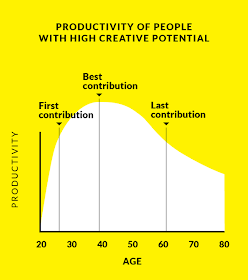Today we hear of Lifehacking, coming up with little tips and tricks to make life easier and better. Another version of life hacking comes from Dave Asprey, former Silicon Valley entrepreneur and venture capitalist, who spent $300,000 of his own money investigating how to improve his body and mind non-invasively. His small business, The Bulletproof Executive, sells things he's productized and information he has gleaned to improve health.
Dave lost 100 pounds without counting calories or excessive exercise, used techniques to upgrade his brain by more than 20 IQ points, and lowered his biological age while learning to sleep more efficiently in less time. Learning to do these seemingly impossible things transformed him into a better entrepreneur, a better husband, and a better father.As he puts it, he hacked his own biology to become better at everything. (I've heard him interviewed once or twice - he's an interesting guy!)
But hacking ourselves goes beyond this, into the emerging field of biohacking: people doing direct surgical modifications of themselves and introducing technology into their bodies in an attempt to improve or enhance themselves. This piece, on the UK website MakeUseOf.com describes some of the things people are having done to themselves:
“Sorry about the mess,” says Steve Haworth, as we walk down the stairs to the surgical theater in his basement. My friend Ted is visibly pale and sweating – for good reason. He’s about to get a sixth sense the hard way: by way of a scalpel, a needle and thread, and a tiny, gold-plated rare-earth magnet. Haworth is a body modification expert with a particular interest in what’s called “biohacking” – the practice of merging consumer technology and the human body to produce uniquely functional body modifications.Why implant a magnet into your finger? To "experience" magnetic fields in new and different ways.
Haworth has several already installed in his own body, which he shows us as he moves his hand through the air next to his running can opener. Sure enough, you can feel the magnet twitch and jump in response to the electromagnetic field generated by the motor. It’s startling, and shows off exactly what you’re getting for your three hundred and fifty dollars: the ability to feel the shape and strength of electromagnetic fields in the world around you. Our host describes someone who had the procedure done, and was startled, when walking through New York City, to discover the powerful electromagnetic field produced by an electrical junction under the sidewalk.There's an unmistakable scent of "latest hip trend here" and attracting people intently wanting new experiences. For example, the MakeUseOf piece has an embedded video by a young German girl playing with the magnet in her ring finger, and one of the comments is from a 13-year old asking if it was legal and if he could get it. But it goes beyond that. Kevin Warwick, professor of cybernetics at Coventry University, was the world's first man to get a silicon chip implanted in his arm and learn to control things in the outside world with it.
By capturing electrical signals flowing down his arm, Warwick was able to control a robotic wheelchair, and remote-control a robotic hand over the Internet. Later, his wife had a similar electrode grid implanted, allowing them to communicate with direct nerve impulses via the Internet.It made the Warwicks the first people on earth to feel each other's nerve impulses.
“It didn’t feel like pain or heat or seeing. It was like an entirely new sense. And that was part of the experiment: to see if the brain can adapt and take on new types of input and learn to understand. The brain is very clever like that—I just want to see how far we can push it.”There are obvious applications here for better prosthetics and better cyborgs (Warwick himself has been called "Captain Cyborg"). Imagine developing interface chips that can be implanted in someone who lost a limb, and a prosthetic that takes the same nerve impulses that used to move the real arm and turns them into equivalent motions in the prosthetic. It doesn't seem remotely more difficult to give tactile feedback to the person through those same interfaces.
The progress in cochlear implants for the deaf has been remarkable, and there's talk that video implants are not far behind. Blindness and deafness defeated?
Most forms of total deafness are curable these days, via the use of a cochlear implant — a chip implanted in the nerves of the ear that uses several electrodes to translate sounds from a worn microphone into electrical signals to the brain. The audio quality is not as good as in a normal ear, but electrode densities are improving, and modern cochlear implants are good enough to understand speech without lip reading in a quiet room, and even to appreciate music (though audiophiles will probably complain about the bitrate).Steve Mann - quite possibly the first victim of anti-cyborg hate crime - and a version of Eyetap. That's not a Google Glass, it's physically attached to his skull by several screws. It entirely captures the visual input to one eye, runs it through a computer to attach additional information, and then displays it on a small near-eye screen.
...
Even more ambitiously, scientists have reverse-engineered the retina, and created a computer program that reproduces its operation. This allows you to connect cameras to the optic nerve as though they were living eyes, and have the cameras speak to the brain on its own terms, providing a much more natural approximation of normal vision than has otherwise be possible. In principle, these cameras could eventually exceed human vision – implementing optical zoom, active night vision, and the ability to see the non-visible portions of the spectrum.
This is clearly the beginnings of transhumanism, perhaps the early stages of Vernor Vinge's Singularity that has been written about at great lengths elsewhere. There are parts about all of these procedures that are creepy: the discussion about the surgery to implant the magnets made me think of the Joker getting his face fixed in some dirty ex-hospital, or Tom Cruise getting new eyeballs in Minority Report. I'll hand the conclusion back off to MakeUseOf:
The future is here – and, while it’s often rough around the edges, anyone with two cents worth of vision to rub together can see that near future is going to be tumultuous and wonderful and strange beyond measure. That’s the philosophy that drives biohacking – fulfilling the promises of science fiction a little at a time, as the future slowly becomes more evenly distributed. Right now, it’s expensive, painful, and sketchy enough that it’s pretty much reserved for enthusiasts, DIYers and other people who are not entirely sane. The tech is getting better, though, and sooner or later it’s going to move into the mainstream in the same way that tattoos and piercings have. Your grandmother may someday be showing off the implants that remind her where she is and monitor her health to call for help if something goes wrong. Your aunt might have robotic eyes that can see things that human eyes never could. When you’re old, maybe you’ll opt for enhanced legs and a porcine heart. At this point in time, it’s a question of ‘when’, and not ‘if.’





















